B2.5 Add and subtract fractions with like and unlike denominators, using appropriate tools, in various contexts.
Skill: Adding and Subtracting Fractions With Like and Unlike Denominators, Using Appropriate Tools and Strategies
Making connections between operations on whole numbers and operations on fractions
By Grade 6, students have already developed a solid understanding of addition and subtraction. It is important to make connections between operations on whole numbers and operations on fractions. For example, adding 3 eighths and 2 eighths is the same as adding 3 candies and 2 candies. Only the notation is different.
Source: translated from Guide d’enseignement efficace des mathématiques de la 4e à la 6e année, Numération et sens du nombre, Fascicule 2, Fractions, p. 75.
Valuing Informal Procedures to Develop Strategies
It is important to value informal procedures, as they contribute to the development of number sense and operational sense. In situations that involve operations, many students use personal algorithms rather than procedures. For example, a student with good number sense could tackle the addition of \(\frac{7}{8}\) of a sandwich and \(\frac{4}{8}\) of another identical sandwich in this way: "I know that with \(\frac{7}{8}\) of a sandwich, I have \(\frac{1}{8}\) less than a whole sandwich. So if I add \(\frac{1}{8}\) to \(\frac{7}{8}\), I have a whole sandwich and I'm left with \(\frac{3}{8 }\) of the second sandwich. So, altogether I have \(\frac{7}{8}\; + \;\frac{4}{8}\; = \;1\frac{3}{8}\) sandwiches. »
Source: translated from Guide d’enseignement efficace des mathématiques de la 4e à la 6e année, Numération et sens du nombre, Fascicule 2, Fractions, p. 76.
Nature of the Fundamental Operations
Applying an operation on numbers has the effect of changing the quantities involved. It is very important that students understand this aspect of quantity when using addition, subtraction, multiplication and division. Junior students have had the opportunity to learn about these relationships in relation to the operations on whole numbers. For addition, two quantities are put together and result in a new quantity. For subtraction, one quantity is taken away from another quantity to result in a new quantity. We can also recognize that we are looking for the difference between two quantities.
It takes a long time to build a sense of operations with fractions, as one must think about the numerators, denominators, and all involved. Students should be given the opportunity to work with concrete and visual (semi-concrete) models before moving on to operations involving symbolic representations. A key concept for students to understand is that when adding or subtracting fractions, we can only add and subtract like things; in the same way that adding and subtracting whole numbers is essentially adding the unit "ones".
According to the Ontario Curriculum, the expectation is that Grade 6 students add and subtract fractions with and without like denominators.
For addition and subtraction with like denominators, it is essentially the addition and subtraction of units, objects or quantities of the same kind.
For example, in \(\frac{3}{7}\; + \;\frac{2}{7}\; = \;\frac{5}{7}\), the addition simply represents \( 3\;{\rm{one \ sevenths}}\; + \;2\;{\rm{one \ sevenths}}\; = \;5\;{\rm{one \ sevenths}}\), any like 3 apples + 2 apples = 5 apples. In this example, one sevenths (the unit fraction) are counted the same way as apples. We have 3 parts of a certain size and 2 parts of the same size, which gives 5 parts of that size.
Subtraction is treated the same way. For example, if I take 3 marbles out of a bag that contains 5 marbles, 2 marbles remain. Similarly, if I subtract 3 one eighths from 5 one eighths, I have 2 one eighths left (\(\frac{5}{8}\; - \;\frac{3}{8}\; = \;\frac{2}{8}\)).
Adding two whole numbers results in a quantity greater than the initial quantity, while subtracting one whole number from another results in a quantity that is less than the initial quantity. It is important for students to understand that the same is true for adding and subtracting fractions.
This supports students to understand the implausibility of certain answers obtained from erroneous procedures. For example, the student who, to calculate \(\frac{2}{3}\; + \;\frac{1}{3}\), adds the numerators and denominators and obtains \(\frac{3 }{6}\), should see that this answer, which is equal to \(\frac{1}{2}\), is less than one of the initial fractions, i.e. \(\frac{2}{3}\).
Source: translated from Guide d’enseignement efficace des mathématiques de la 4e à la 6e année, Numération et sens du nombre, Fascicule 2, Fractions, p. 76-77.
Exploring Operations Using Multiple Models
It is important for students to learn fraction-related concepts in a variety of situations using a variety of models such as area models, linear models, and set models. The same is true for learning operations on fractions.
Source: translated from Guide d’enseignement efficace des mathématiques de la 4e à la 6e année, Numération et sens du nombre, Fascicule 2, Fractions, p. 76.
When working with fractions, the most important and sometimes the most difficult part is correctly representing the whole. With concrete or visual (semi-concrete) materials, the visual effect of addition and subtraction is enhanced. Drawing on their experiences with whole numbers and developing a sense of operation, students can recognize, for example, that adding two thirds to one third results in three thirds, or a whole.
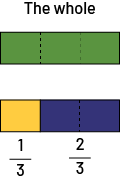
However, it is not always clear to students that addition is in relation to the numerator. In a situation where there are three eighths left of a pizza and two eighths left of another pizza of the same size, when determining how much is left, we need to think about how many eighths are left in total. We are counting eighths, not sixteenths, even though the pizzas had a total of 16 pieces?

Students progress to problems involving fractions with different denominators. However, students can explore this type of problem in context using concrete and visual representations.
For example, Alexis and his brother Mycolas each have a granola bar. The bars are identical. Alexis ate one-third of her granola bar and Mycolas ate three fourths of his. How much of the granola bar do they have left? While this is a challenging situation for students, if they use concrete materials to model the situation, or make a visual representation of it, they are able to conclude that there is almost a whole granola bar left.
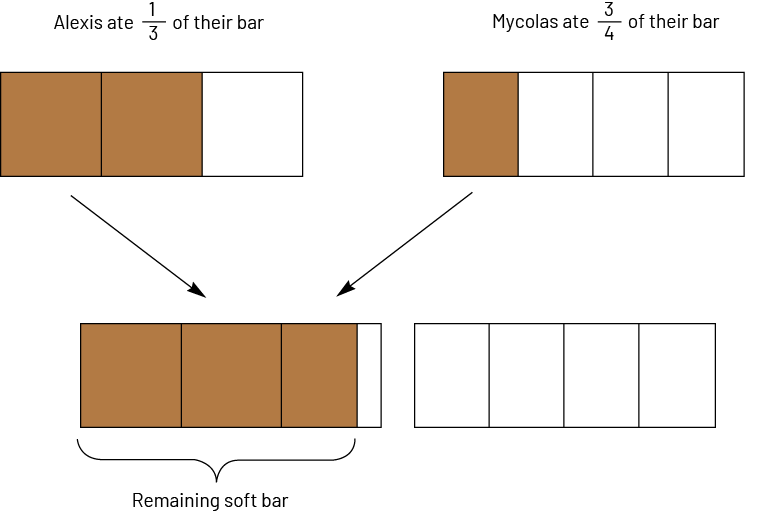
This situation can be represented using an area model. The rectangular shape is natural, since it looks like a granola. However, other representations, such as the linear model, should not be overlooked.
The following example is about distance and uses fractional numbers:
As part of his training for a race, William must run at least 6 \(\frac{1}{10}\) km a day. This morning, before going to school, he ran 3 \(\frac{3}{10}\) km. How many kilometres does he have to run after school?
Since the situation deals with a linear measurement, students can use a linear model such as a number line. The first step is to locate 6 \(\frac{1}{10}\) on a graduated number line (below left) or an open number line (below right):

then subtract 3 from 6

then subtract the fractional part, \(\frac{3}{10}\).

Thus, we can conclude that William must travel 2 \(\frac{8}{10}\) km (\(6\frac{1}{10} - 3\frac{3}{10} = \;2\frac{8}{10}\)).
Students should also explore situations involving improper fractions. For example, the operation \(\frac{{10}}{4} + \frac{3}{4}\) could be represented using the following model.

This model shows that the result is \(\frac{13}{4}\), if we count the fourths, or 3 \(\frac{1}{4}\), if we take into account the whole.
Source: translated from Guide d’enseignement efficace des mathématiques de la 4e à la 6e année, Numération et sens du nombre, Fascicule 2, Fractions, p. 92-94.
The following are different types of problems relating to addition and subtraction (change problems (joining and separating), comparing problems and combining problems).
Examples
Joining Problems
- Mila ate \(\frac{2}{8}\) of a submarine, while Peter ate \(\frac{1}{2}\) of it. What fraction of the submarine was eaten by the two children?
\(\frac{2}{8}\; + \frac{1}{2}\; = \;?\)
Representation using fractional strips:
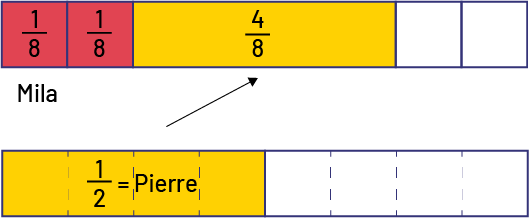
\(\frac{6}{8}\;{\rm{or}}\;\frac{3}{4}\) of the submarine was eaten by the two children.
Source: translated from Guide d’enseignement efficace des mathématiques de la 4e à la 6e année, Numération et sens du nombre, Fascicule 2, Fractions, p. 78.
- The red ant measures \(\frac{3}{{10}}\) centimetres, the cicada measures \(1\frac{1}{5}\) centimetres, the beetle measures \(\frac{2}{{10}}\) of a centimetre and the ladybug measures \(\frac{3}{{10}}\) of a centimetre. What improper fraction represents the length in cm of the sequence of insects? What is this length in metres?
To add fractions, you need to represent them with a common denominator.
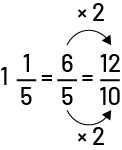

\(\frac{12}{10} + \frac{3}{{10}} + \frac{2}{10} + \frac{3}{10} = \frac{20}{10} = 2\)
Its length is \(\frac{20}{{10}}\) centimetres or 2 cm. Its length in metres is 0.02 m.
Source: Adapted and translated from L'@telier - Ressources pédagogiques en ligne (atelier.on.ca).
Comparing Problem
Mila used \(\frac{1}{4}\) of a pitcher to water her plant. Peter used \(\frac{5}{8}\) of a pitcher to water his plant. What fraction represents the difference between the amounts of water used by Peter and Mila?
To subtract fractions, one may choose to represent them using a common denominator. So, for Mila's quantity of water, one could find the equivalent fraction that has the same denominator as the other fraction. For example, "I know that 8 is a multiple of 4. So I multiply the denominator by 2 to get eights, and I then multiply the numerator by 2 to find an equivalent fraction, which is \(\frac{2}{{8}}\).

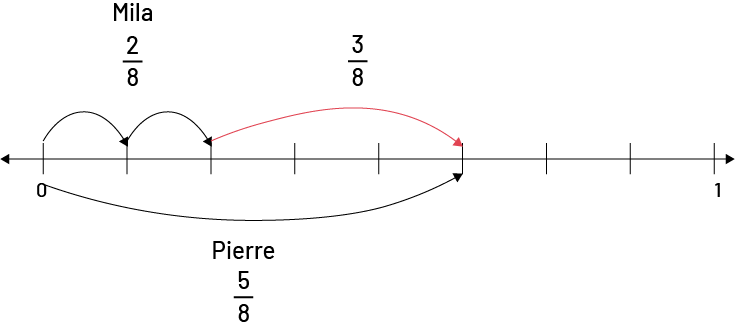
There is a difference of \(\frac{3}{{8}}\) of a pitcher of water between what Mila used to water her plant and what Peter used to water his plant.
Source: translated from Guide d’enseignement efficace des mathématiques de la 4e à la 6e année, Numération et sens du nombre, Fascicule 2, Fractions, p. 78.
Knowledge: Denominator
The denominator represents the total number of equal parts into which a whole or set is divided. It is the number below the line in a fraction.
For example, the whole is a length.
The denominator of the segment is black. The denominator "3" of the fraction \(\frac{2}{3}\), represents the 3 equivalent sectioned parts of the number line.

Knowledge: Numerator
The numerator represents the counting number of parts of a whole. It is the number above the line in a fraction.
For example, the whole is a length.
\(\frac{2}{3}\) of the segment is red. The numerator "2" of the fraction \(\frac{2}{3}\), represents the 2 red parts of the 3 equivalent sections of the number line.

Source: translated from Guide d’enseignement efficace des mathématiques de la 4e à la 6e année, Numération et sens du nombre, Fascicule 2, Fractions, p 32 and 34.
